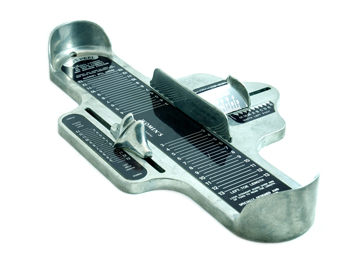
Engaging regularly in high-impact activities, such as basketball, running, or professional dancing, may expose you to the discomfort of a foot stress fracture. This overuse injury involves hairline cracks in the weight-bearing bones of the foot. If left untreated, a stress fracture in the foot can escalate into a more serious concern. However, stress fractures are not always easy to diagnose. Pain upon weight-bearing activities that often subsides after rest is a primary indicator of stress fractures. Tenderness in the affected area, occasional bruising, and swelling around the ankle are other signs to be noted. Various factors contribute to the development of stress fractures in the foot. Overuse and repetitive stress, stemming from prolonged engagement in activities without adequate rest, can subject the foot bones to cumulative stress. Wearing inadequate footwear, whether ill-fitting or worn out, further elevates the risk by providing insufficient support and shock absorption. Suddenly increasing the intensity or duration of physical activity can overwhelm the bones, especially without sufficient time to adapt. Poor biomechanics, such as flat feet or high arches, also can redistribute pressure unevenly across the foot, contributing to stress fractures. If you believe you may have incurred a foot stress fracture, it is suggested that you schedule an appointment with a podiatrist for a thorough exam and suitable imaging tests. Treatment options appropriate to the severity of the injury will follow.
Activities where too much pressure is put on the feet can cause stress fractures. To learn more, contact Bruce Smit, DPM from Frankfort Foot & Ankle Clinic. Our doctor can provide the care you need to keep your pain free and on your feet.
Dealing with Stress Fractures of the Foot and Ankle
Stress fractures occur in the foot and ankle when muscles in these areas weaken from too much or too little use. The feet and ankles then lose support when walking or running from the impact of the ground. Since there is no protection, the bones receive the full impact of each step. Stress on the feet can cause cracks to form in the bones, thus creating stress fractures.
What Are Stress Fractures?
Stress fractures occur frequently in individuals whose daily activities cause great impact on the feet and ankles. Stress factors are most common among:
Symptoms
Pain from the fractures occur in the area of the fractures and can be constant or intermittent. It will often cause sharp or dull pain with swelling and tenderness. Engaging in any kind of activity which involves high impact will aggravate pain.
If you have any questions please feel free to contact our office located in Frankfort, IL . We offer the newest diagnostic and treatment technologies for all your foot and ankle needs.

In the world of podiatry, the Brannock device stands as an indispensable tool, forging a vital connection between podiatrists and accurate foot measurements. This device, designed with precision and ergonomic considerations, facilitates the podiatrist's ability to assess the unique characteristics of an individual's feet. Serving as more than just a sizing tool in retail, the Brannock device aids podiatrists in diagnosing and addressing various foot-related conditions. Podiatrists leverage the Brannock device to gather critical data on foot length, width, and arch structure, contributing to a comprehensive understanding of a patient's foot anatomy. This nuanced information guides the podiatrist in recommending appropriate footwear, orthotic interventions, or customized treatment plans tailored to the individual's specific foot structure. The Brannock device, with its meticulous measurements, not only enhances the accuracy of diagnosis but also plays a pivotal role in advancing personalized and effective podiatric care. It is suggested that you visit a podiatrist who can show you how the Brannock device can determine what your correct shoe size is.
Getting the right shoe size is an important part of proper foot health. Seek the assistance of Bruce Smit, DPM from Frankfort Foot & Ankle Clinic. Our doctor will provide the care you need to keep you pain-free and on your feet.
Getting the Right Shoe Size
There are many people who wear shoes that are the incorrect size, negatively affecting their feet and posture. Selecting the right shoes is not a difficult process, so long as you keep several things in mind when it comes to choosing the right pair.
As our feet hold our body weight and keep us moving, it is important to treat them right. Picking the right pair of shoes can provide your feet comfort and mobility without pain.
If you have any questions, please feel free to contact our office located in Frankfort, IL . We offer the newest diagnostic and treatment technologies for all your foot care needs.

Approximately 60,000 lower extremity amputations are performed annually in the United States in patients with diabetes. This fact makes ulceration, infection, and gangrene a prevalent foot and ankle issue for diabetics people. Many amputations can be prevented through daily foot care habits and regular visits to a podiatrist to monitor foot ulcers. These experts suggest adopting an everyday foot care routine of inspecting the feet thoroughly for any changes in shape, color, sensation, or skin integrity. To prevent complications, podiatrists also recommend a gentle cleaning that involves washing feet in lukewarm water with mild soap, avoiding soaking, and ensuring thorough drying, especially between the toes. Nail care includes trimming nails straight across, avoiding rounding the corners. Callus management suggests gently reducing calluses with a foot file or pumice stone, rubbing in one direction to avoid skin tears. Diabetic patients should opt for cushioned, breathable shoes with soft uppers. Choosing cotton or natural fiber socks over synthetic materials is recommended. If you have diabetes, and are experiencing foot ulcers, it is suggested that you are under the care of a podiatrist who is medically trained to manage this condition.
Limb salvage can be an effective way in preventing the need for limb amputation. If you have diabetes, cancer, or any other condition that could lead to foot amputation if left unchecked, consult with Bruce Smit, DPM from Frankfort Foot & Ankle Clinic. Our doctor will assess your condition and provide you with quality foot and ankle treatment.
What Is Limb Salvage?
Limb salvage is the attempt of saving a limb, such as the foot from amputation. Podiatrists also try to make sure that there is enough function in the foot after the salvage that it is still usable. Diabetes is the number one cause of non-traumatic amputations in the United States. Those with diabetes experience poor blood circulation, which prevents proper healing of an ulcer. If the ulcer is left uncheck, it could become infected, which could result in the need for amputation.
However, there are other causes as well, such as cancer and traumatic injury. Links between higher mortality rates and amputation have been found. This translates into higher healthcare costs, and a reduced quality of life and mobility for amputees. Podiatrists have attempted to increase the prevalence of limb salvage in an attempt to solve these issues.
Diagnosis and Treatment
Limb salvage teams have grown in recent years that utilize a number of different treatments to save the infected limb. This includes podiatrists that specialize in wound care, rehabilitation, orthotics, and surgery. Through a combination of these methods, limb salvage has been found to be an effective treatment for infected limbs, and as an alternative to amputation. Podiatrists will first evaluate the potential for limb salvage and determine if the limb can be saved or must be amputated.
If you have any questions, please feel free to contact our office located in Frankfort, IL . We offer the newest diagnostic and treatment technologies for all your foot care needs.

Ankle injuries, a common woe for sports enthusiasts, often leave you wondering: Is it a sprain or a break? Understanding the nuances is imperative for effective treatment. A sprain occurs when ligaments, which are the connectors between bones and joints, are forcefully stretched beyond their normal range. Notably, ankle sprains take the lead as the most prevalent sports injury. Conversely, a fracture entails a break in a bone, with a broken ankle indicating damage to tibia and fibula in the leg or calcaneus and talus bones of the foot. Fractures cause sudden pain and noticeable swelling, whereas stress fractures, smaller cracks in the bone, bring intense pain with less swelling. When uncertainty looms, seeking medical guidance is paramount. Consult a podiatrist if you suspect a fracture or ruptured ligament. Tenderness over a bone and an irregular shape of the leg or joint may signify a break or dislocation, necessitating immediate attention. An accurate diagnosis ensures the right intervention, whether it is rest and rehabilitation for a sprain or more intensive measures for a fracture. If you have sustained a serious ankle injury, be it a sprain or a fracture, it is suggested that you schedule an appointment with a podiatrist.
Although ankle sprains are common, they aren’t always minor injuries. If you need your ankle injury looked at, contact Bruce Smit, DPM from Frankfort Foot & Ankle Clinic. Our doctor can provide the care you need to keep you pain-free and on your feet.
How Does an Ankle Sprain Occur?
Ankle sprains are the result of a tear in the ligaments within the ankle. These injuries may happen when you make a rapid shifting movement while your foot is planted. A less common way to sprain your ankle is when your ankle rolls inward while your foot turns outward.
What Are the Symptoms?
Preventing a Sprain
Treatment of a Sprain
In many cases, the RICE method (Rest, Ice, Compression, and Elevate) is used to treat ankle sprains. However, you should see a podiatrist to see which treatment option would work best with your injury. In severe cases, surgery may be required.
It is important to ask your doctor about rehab options after you receive treatment for your injury. Stretching, strength training, and balance exercises may help the ankle heal while also preventing further injury.
If you have any questions, please feel free to contact our office located in Frankfort, IL . We offer the newest diagnostic and treatment technologies for all your foot care needs.